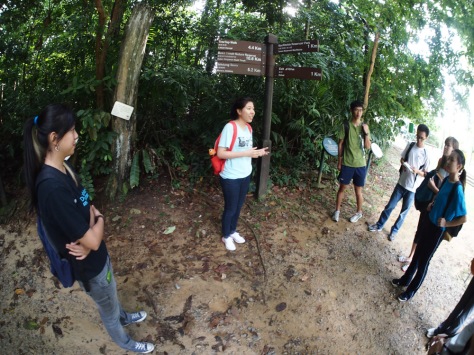A few months ago, the BES Drongos was merely an idea to bring the public around a nature reserve in Singapore to emphasise the importance of nature and let them experience natural spaces for themselves. Now, we are a volunteer group of 25 Bachelor of Environmental Studies students who are proud to call ourselves the BES Drongos nature trail guides. We spent months organising ourselves through recee trails and concluded our first ever trail season last month after taking eight groups of trail participants onto the Petai Trail!

As a guiding group, we are still young and have much to learn about how the public interacts with nature – what’s interesting to us as nature lovers and scientists-in-training may not engage families, young children or people who are there to take selfies photographs.
“When you get caught up in the things that went wrong, always think about how we started with nothing.”
– Jacqueline, our research officer
This trail season, we took seven groups of trail participants onto the Petai Trail at MacRitchie Reservoir Park/Central Catchment Nature Reserve. Mother Nature doesn’t take cues for scheduling according to our walks. Our first ever opening walk day on 4 October was rained out, despite a full turnout from the participants who had signed up. Nevertheless, we were lucky to have been able to allow all walks after that to continue as expected!
4 Oct – it rained 😦
11 Oct

12 Oct

18 Oct

25 Oct

1 Nov

9 Nov

15 Nov

We were glad to have interested participants come on our trails who enjoyed exploring and finding out about nature as much as we do! Some of our participants came from abroad, and they brought with them interesting stories about other nature walks back in their home country and the kinds of animals they have seen.
Each of the walks was an exchange of knowledge and wonderment, as we continued to learn about the wildlife in our nature reserve and broaden our perspectives about what it means to live in a city that claims to be fully urbanised, but has pockets of nature worth preserving.
For instance, we experienced some kind of (nerdy) joy when we managed to overturn common misconceptions about forests: tropical rainforest soils are actually nutrient poor because of heavy rainfall leaching away the nutrients. Therefore, plants like the leaf litter plant (Agrostistachys indica) to flourish because of their clever way of trapping leaf litter and absorbing nutrients from this decomposing matter through its rootlets.
We also spotted lots of variable animals in the nature reserve! We have talked about the Greater racket-tailed drongo, the long-tailed macaque, the Asian softshell turtle and common sun skink in this earlier post.

While on our recce walk with the Toddycats, we spotted an ornate coraltail dragonfly and two venomous snakes! The Blue Malayan Coral snake and the Wagler’s pit viper (which we also later saw once more on the trail with public participants) were rare finds that we got really excited about and blogged here.

We also encountered on our public walks some new animals that we hadn’t seen before, such as this pin-striped tit babbler:


On this same walk, we encountered some crimson sunbirds, the unofficial national bird of Singapore! Tanvi, the young creator behind the blog Saving MacRitchie, was a participant on this same walk and these photos were taken by her.
And, we’ve captured some footage of a pair of greater racket-tailed drongos along the Petai trail, how awesome is this? Note the tail flicks!
We hope that we’ve touched the lives of the people who have come on the trail with our stories of the animals and plants that are found along the Petai Trail in the secondary forest of MacRitchie. Our guides have learned a lot about environmental education, whether it is storytelling to engage an audience or public speaking practice. We are infinitely glad to have the support of our BES office in NUS, our readers of this blog and followers on our Facebook page and everyone who has helped to support us in one way or another.
Let us know if you came on the trail and have something to share about your experience! Mail us at besdrongos@gmail.com or drop us a comment on our Facebook page!
The BES Drongos will be resuming guided Petai trail walks in 2015, so until then, we wish you happy holidays and a happy new year!
Words by: Judy Goh



















